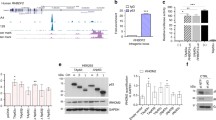Summary
Parakeratosis (PK) is a common feature of the abnormal epidermis in several disorders of keratinization. Tar phenols, retinoids and steroids which cause the inhibition of PK and the restoration of orthokeratosis (OK) are used for treating psoriasiform conditions. In this work, we studied two experimental models of the drug-induced inhibition of PK:(1) the suppression of the normal development of PK in the infant mouse tail and (2) the OK conversion of established PK in the adult tail. Two markers of OK were studied: the histological evaluation of the granular layer and the expression of cytoplasmic antigens linked to OK differentiation. It was demonstrated that high-boiling tar phenols cause a more potent inhibition of PK than betamethasone valerate. Most importantly, immunofluorescence showed that the switch to OK differentiation was located in the cells situated in a suprabasal position. The use of these immunological markers to investigate and anti-parakeratotic mechanisms has revealed that these drugs act at stages of keratinocyte differentiation which are distinct from those previously suggested.
Similar content being viewed by others
References
Braun-Falco O (1956) Beitrag zum histochemischen Nachweis von Esterasen in normaler und psoriatischer Haut. Arch Klin Exp Dermatol 202:153–162
Braun-Falco O (1958) Histochemistry of psoriasis. Ann NY Acad Sci 73:936–976
Didierjean L, Woodley D, Regnier M, Prunieras M, Saurat J-H (1981) Skin explant cultures: expression of cytoplasmic differentiation antigens in outgrowth cells. J Invest Dermatol 76:38–41
Didierjean L, Wrench R, Saurat J-H (1983) Expression of cytoplasmic antigens linked to orthokeratosis during the development of parakeratosis in newborn mouse tail epidermis. Differentiation 23:250–255
Galoppin L, Didierjean L, Saurat J-H (1981) Etude de la fixation des anticorps anti-cytoplasme des keratinocytes. Discussion du rôle du fragment Fc. Ann Dermatol Venereol 108:201
Jarrett A, Spearman RIC (1964) Histochemistry of the skin — psoriasis. English University Press, London
Jarrett A, Wrench R, Mahmoud B (1979) Granular layer induction following the topical application of proliferating agents. Arch Dermatol Res 264:143–151
Laovari D, Pavlovitch H, Deceneux G, Balsan S (1980) A vitamin-D-dependent calcium-binding protein in rat skin. FEBS Lett 111:285–289
Römer F (1896) Studien über das Integument der Säugetiere. I. Die Entwicklung der Schuppen und Haare am Schwanze und an den Füssen von Mus decumanus und einigen anderen Muriden. Jena Z Med Naturwissenschaft 30:604–622
Saurat J-H, Didierjean L (1980) Antibodies to outer root sheath of hair. Distinct antigenic properties of the basal cell layer of the outer root sheath below the saebaceous gland canal. Br J Dermatol 102:419–427
Saurat J-H, Didierjean L, Galoppin L, Gluckman E (1978) Antibodies with affinity to the cytoplasm of keratinocytes produced after bone marrow transplantation in man. A review. Cut Immunopathol INSERM (Paris) 80:77–92
Saurat J-H, Didierjean L, Beucher F, Gluckman E (1978) Immunofluorescent tracing of cytoplasmic components involved in the keratinocyte differentiation. Br J Dermatol 98:155–163
Saurat J-H, Didierjean L, Habibi B (1981) Pr-antigens in the skin: distinct localization linked to the stage and the type of keratinocyte differentiation. Br J Dermatol 105:25–38
Saurat J-H, Didierjean L, Pavlovitch J-H, Laovari D, Balsan S (1981) Skin calcium-binding protein is localized in the cytoplasm of the basal cell layer of the epidermis. J Invest Dermatol 76:221–223
Schweizer J, Marks F (1977) A developmental study of the distribution and frequency of Langerhans cells in relation to formation of patterning in mouse tail epidermis. J Invest Dermatol 69:198–204
Spearman RIC (1964) The evolution of mammalian keratinized structures. In: Ebling J (ed) The mammalian epidermis and its derivatives. Symposium of the Zoological Society London no. 12. Academic Press, London, pp 67–81
Wrench R (1977) Changes in mouse tail epidermal keratinization induced by tar derivatives. In: Spearman RIC (ed) Comparitive biology of skin. Symposium of the Zoological Society London no. 39. Academic Press, London, pp 353–372
Wrench R (1981) Scale prophylaxis. A new antiparakeratotic assay. Arch Dermatol 117:213–215
Wrench R, Britten AZ (1975) Evaluation of coal tar fractions for use in psoriasiform diseases using the mouse tail test. III. High boiling tar oil acids. Br J Dermatol 93:67–74
Author information
Authors and Affiliations
Rights and permissions
About this article
Cite this article
Wrench, R., Didierjean, L. Antibodies to orthokeratotic keratinocytes in monitoring the drug-induced inhibition of parakeratotic differentiation in adult and infant mice. Arch Dermatol Res 277, 201–208 (1985). https://doi.org/10.1007/BF00404317
Received:
Issue Date:
DOI: https://doi.org/10.1007/BF00404317




